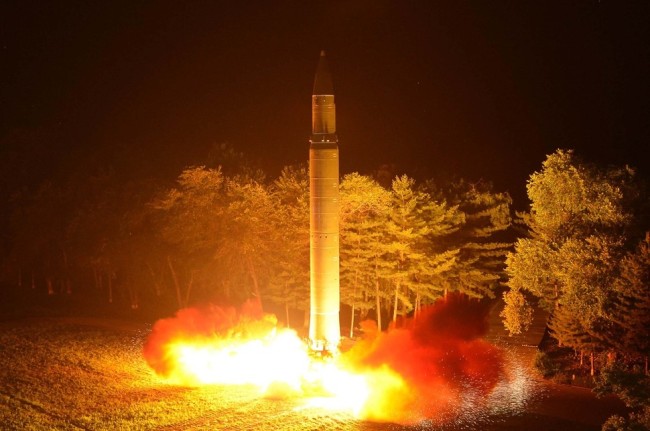NK’s new ICBM still lacks key technology: experts
By Jung Min-kyungPublished : Nov. 29, 2017 - 18:04
North Korea declared completion of its missile development program Wednesday by claiming success in test-firing of its longest-range intercontinental missile to date, but outside experts said the communist regime is not there yet.

The missile reached an altitude of around 4,500 kilometers and flew 960 kilometers before landing in the East Sea, South Korea’s Joint Chiefs of Staff said. It was launched from the vicinity of Pyongsong, South Pyongan Province, 30 kilometers north of Pyongyang at around 3:17 a.m., on a lofted trajectory.
JCS initially suspected it to be a Hwasong-14 class missile, the two-stage intercontinental ballistic missile Pyongyang launched twice in July, but the North revealed it as the new Hwasong-15 missile, an upgraded version of the Hwasong-14.
Around noon on Wednesday, the North claimed a successful liftoff of its Hwasong-15, which it says is capable of hitting the US mainland and designed to carry a heavy nuclear warhead, through its state media Korean Central News Agency.
“The ICBM Hwasong-15 type weaponry system is an intercontinental ballistic rocket tipped with a super-large heavy warhead which is capable of striking the whole mainland of the US,” KCNA said.
“The rocket soared to the highest altitude of 4,475 km and then flew the distance of 950 km.”
It traveled for nearly 50 minutes, North Korea added, which is the longest of the nation’s missile flights.
KCNA lauded the new missile by stressing that the technological features were a vast improvement from those of the Hwasong-14. The improvements propelled its weapons development program to enter the final stages of completion, it said.
The Washington Post said that the missile “flew 10 times higher than the International Space Station” which theoretically puts Washington DC within its target range. Hwasong-15 rose about 1.6 times higher compared to its previous version, which reached an altitude of 2,802 km in its test on July 4 and 3,700 km on July 28.
However, it also pointed out the increase in range may mean the missile was fitted with a light mock warhead, citing scientists. The projectile may not achieve the same level of range when carrying a heavier warhead, it said.
Although the North didn’t specify the technological advance it had made, experts here believe it has yet to secure the atmospheric re-entry technology, a core element in completing its ICBM program. As an ICBM re-enters the atmosphere and falls at a top speed of Mach 24, it must endure temperatures of 6,000-7,000 degrees Celsius.
“The test was North Korea’s effort to examine and confirm its updated technology,” Kim Dong-yup, a professor at Kyungnam University’s Far East Institute said, while pointing to the absence of the North’s reports of a successful atmospheric reentrance.
“Hwasong-14 has never demonstrated the capability to re-enter the earth’s atmosphere after having been launched at a range-maximizing trajectory. (A successful atmospheric re-entry) after being launched from such angle will signal the completion of the North’s nuclear weapons program,” he said.
“It seems North Korea has failed to acquire the missile’s atmospheric re-entry technology (this time).”
The test could have also acted as a check-up session before carrying out the plan of dropping a hydrogen bomb in the Pacific, which the North’s Foreign Minister Ri Yong-ho mentioned in September, Kim said in a separate Facebook post. The North could launch the missile at a normal trajectory by the end of 2017, he added.
Another expert said although the North failed to secure the re-entry technology it managed to succeed in securing its goal distance. Based on the missile’s trajectory and distance, it would have a range of more than 10,000 to 11,000 kilometers, enough to reach the mainland US.
“The new missile’s altitude of 4,500 kilometers can be interpreted as North Korea’s success in securing sufficient range,” Yang Mu-jin, a professor at the University of North Korean Studies in Seoul said.
“But the Japanese media reported that they saw three projectiles fall into the waters nearby, which strongly indicates that it had not succeeded in re-entering the earth’s atmosphere.”
The experts here also suspected the parts to be propellants for the missile.
South Korean Prime Minister Lee Nak-yon also said that the latest test of a long-range missile might not have been a complete success as it is suspected of losing contact with the control center on the ground during the flight.
The latest launch ended Pyongyang’s 70-day hiatus in military provocations, which fueled hopes of the international community to revive dialogue with North Korea.
It marks the North’s third intercontinental ballistic missile test and 15th ballistic missile launch of 2017.
By Jung Min-kyung (mkjung@heraldcorp.com)








![[Graphic News] More Koreans say they plan long-distance trips this year](http://res.heraldm.com/phpwas/restmb_idxmake.php?idx=644&simg=/content/image/2024/04/17/20240417050828_0.gif&u=)
![[KH Explains] Hyundai's full hybrid edge to pay off amid slow transition to pure EVs](http://res.heraldm.com/phpwas/restmb_idxmake.php?idx=644&simg=/content/image/2024/04/18/20240418050645_0.jpg&u=20240419100350)






![[From the Scene] Monks, Buddhists hail return of remains of Buddhas](http://res.heraldm.com/phpwas/restmb_idxmake.php?idx=652&simg=/content/image/2024/04/19/20240419050617_0.jpg&u=20240419175937)

![[KH Explains] Hyundai's full hybrid edge to pay off amid slow transition to pure EVs](http://res.heraldm.com/phpwas/restmb_idxmake.php?idx=652&simg=/content/image/2024/04/18/20240418050645_0.jpg&u=20240419100350)

![[Today’s K-pop] Illit drops debut single remix](http://res.heraldm.com/phpwas/restmb_idxmake.php?idx=642&simg=/content/image/2024/04/19/20240419050612_0.jpg&u=)